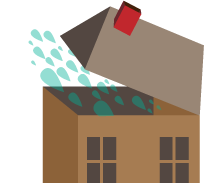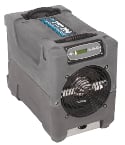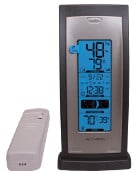 Controlling your indoor environment, specifically the humidity level in your home, is a critical component of an overall effort to reduce your allergy symptoms. As home humidity and house allergies are linked, air that is either too humid or not humid enough can significantly contribute to increased allergy and/or asthma attacks. Here’s how:
Controlling your indoor environment, specifically the humidity level in your home, is a critical component of an overall effort to reduce your allergy symptoms. As home humidity and house allergies are linked, air that is either too humid or not humid enough can significantly contribute to increased allergy and/or asthma attacks. Here’s how:
High Home Humidity and Allergies
Allergy products like allergy relief bedding and microfiber dust cloths deal with allergens directly. In addition, products in your home that control humidity levels, including humidifiers and dehumidifiers, have an often unseen, but significant impact on two of the most common allergens in your home: dust mites and mold.
Dust mites thrive in humid environments. As you may know, dust mites eat skin cells that have been shed from your body. When the environment is humid, our skin absorbs this ambient moisture, making these sloughed-off skin cells a feast of softened tissue for dust mites to eat. In addition, high humidity levels allow dust mites, like other insects, to absorb the moisture they need to survive—insects do not rely on respiration and breathing as humans do. Instead, they often absorb moisture directly through their bodies. Protect yourself and your mattress from dust mites and allergens with Allergy Mattress Covers and Allergy Pillow Covers
Ample nourishment means an increase in dust mite feces—this is the primary component of the dust mite allergen, and it creates stronger dust mites/more dust mites that will breed accordingly. To put it simply, humidity is good news for dust mites and bad news for the majority of people that deal with any type of environmental allergy (since the majority, regardless of a specific diagnosis, are also affected by dust mites). This same link between home humidity and allergies extends beyond dust mites and also applies to cockroaches, another household pest that contributes to allergy problems because of their feces and the skin cells they shed.
 In light of this high-humidity thriving dust mites correlation, the American Academy of Allergy, Asthma & Immunology (AAAAI ) says, “To reduce dust mites, it is important to keep humidity below 50% throughout the home by using a dehumidifier or central or window air conditioning.” In fact, making sure humidity levels are below this 50% threshold drastically reduces dust mite populations; most will die within a few days.
In light of this high-humidity thriving dust mites correlation, the American Academy of Allergy, Asthma & Immunology (AAAAI ) says, “To reduce dust mites, it is important to keep humidity below 50% throughout the home by using a dehumidifier or central or window air conditioning.” In fact, making sure humidity levels are below this 50% threshold drastically reduces dust mite populations; most will die within a few days.
Dust mites aren’t the only allergens that multiply when home humidity is high. Mold, another potent allergen, is also a problem that can arise when humidity levels are high. It only takes fourteen to sixteen hours of over-moist air to activate dormant colony-forming units. Dormant units, which make their way into the home through ventilation systems as well as open doors and windows, are just waiting for the right conditions in order to reproduce.
Since it only takes a matter of hours for colonies of these allergens to begin to multiply, it is important to dehumidify your home immediately when highly humid conditions occur. In addition to a humidity-controlling device like a dehumidifier, consider purchasing an air purifier designed to tackle indoor allergens. These vital tools can help remove dormant mold spores lurking in your home’s air.
Low Home Humidity and Allergies
While air that is too humid leads to increased dust mite allergens and mold problems, air that is too dry can also aggravate allergy, asthma, and eczema symptoms for allergy sufferers.
Although dust mites may begin to die off when humidity levels fall under 50%, allergens will dry out when humidity levels are below 30% relative humidity. Dust mite allergen, mold, and bacteria that are dried out are lighter and, therefore, may become airborne more easily, which can lead to greater inhalation rates. For this reason, air purifiers like the Austin Air Allergy Machine HEGA Air Purifier and the FilterQueen Defender Air Purifier are ideal choices to combat airborne allergens.
In addition, the dry air itself can irritate nasal passages and other mucous membranes, exacerbating allergy symptoms and leading to complications such as sinusitis. When the air in your home is too dry, it can dry out your nasal passages. As the mucus in your nasal passages and airways dries, its ability to trap allergens, bacteria, and viruses (its primary role in regard to your immune system) decreases, leaving you more susceptible to catching a cold, the flu, or causing allergic/asthmatic episodes. Sore throats, chapped lips, dry skin, or allergic dermatitis are other possible repercussions of low home humidity levels. So, if dry air is your concern, a humidifier such as the Boneco S450 Steam Humidifier or the AirCare Essentials Ozark Steam Humidifier will help bring moisture levels up comfortably by using warm steam.
Allergy relief products, including sinus irrigation products and allergy-friendly moisturizers, help to alleviate these symptoms, but they do not address the underlying lack of humidity in the air. To keep the relative humidity within the optimal range, it is important that you run a home humidifier in your home. A humidifier will get to the heart of the matter, restoring moisture back to your indoor air and keeping allergy sufferers comfortable through dry conditions.
Ideal Home Humidity and How to Keep it There
 We recommend a relative humidity level between 40% and 50% for most homes, particularly for those with people who struggle with allergies, asthma, or eczema. Many humidifiers and dehumidifiers have built-in hygrometers or humidity gauges, so the unit will shut off once optimal humidity levels are achieved. However, a stand-alone digital humidity gauge allows you to monitor humidity when you are not running a unit or when you need to check an area that may not yet be receiving humidification or dehumidification treatment.
We recommend a relative humidity level between 40% and 50% for most homes, particularly for those with people who struggle with allergies, asthma, or eczema. Many humidifiers and dehumidifiers have built-in hygrometers or humidity gauges, so the unit will shut off once optimal humidity levels are achieved. However, a stand-alone digital humidity gauge allows you to monitor humidity when you are not running a unit or when you need to check an area that may not yet be receiving humidification or dehumidification treatment.
One of the easiest ways to help keep excess humidity in check is to run a dehumidifier in your home. Dehumidifiers come in all shapes and sizes, but they all do the same thing—remove moisture from the air. While it’s important to note that modern air conditioners often remove some amount of moisture, this is not their primary task, and relying on an air conditioner to reduce the relative humidity in your space can often result in conditions that are conducive to the growth of mold. Air can be cooled yet still feel “sticky” due to high relative humidity. A dehumidifier was specifically designed for the task of removing moisture, and finding the right one for your situation can make all the difference in maintaining healthy humidity levels and a healthy home. Additionally, consider scheduling an ac tune-up to ensure your hvac system is operating efficiently and helping in humidity control. And if you notice some issues with your heating system, it is best to contact a furnace repair contractor as soon as possible.
For individual rooms, brands like Danby offer models that are quieter and more compact than a basement, crawlspace, or whole home dehumidifiers. In addition, some dehumidifiers feature integrated condensate pumps, while all dehumidifiers have an internal water tank to hold the extracted moisture.
When focusing on the basements or crawlspaces, brands like AprilAire, AlorAir, and Ebac offer higher moisture extraction rates and more rugged construction that enables them to withstand harsher conditions. Most dehumidifiers are exceedingly energy efficient and require very little maintenance. Some models, like AprilAire, can also be tied directly into your home’s existing HVAC system to help keep your entire home drier with just one machine.
For some areas of the home or times of the year that pose conditions that are too dry, the use of a humidifier can help to restore a healthy balance to your indoor relative humidity levels. Humidifiers for allergies are particularly helpful during the cooler fall and winter months when forced air heating systems dry out the indoor air. Check out our comprehensive selection of room humidifiers to find localized relief from dry indoor air.
For more information on controlling home humidity and allergies and how humidity can impact your health,
✔ How Humidity Effects The Body
✔ Humidifier Buying Guide
✔ Dehumidifier Buying Guide
✔ Mold Allergies
